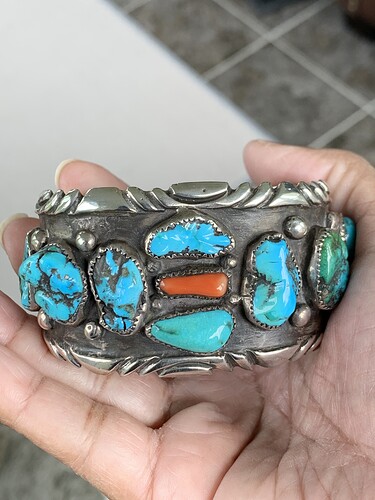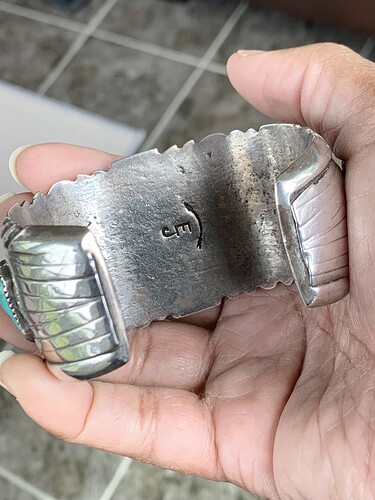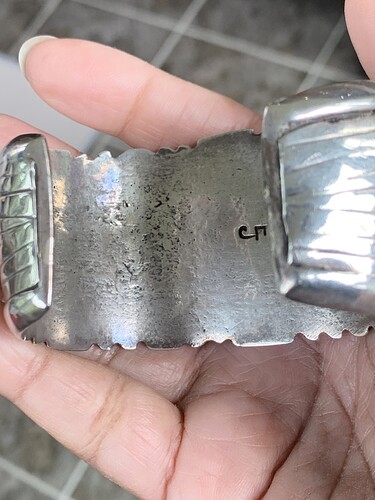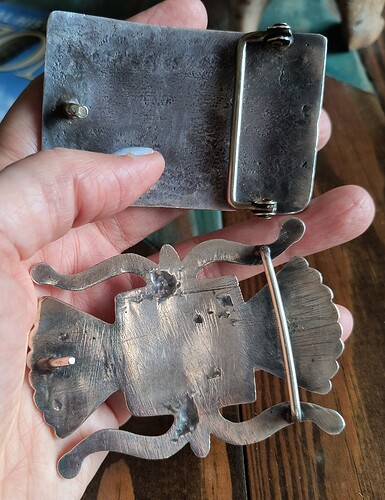Hi again ![]() So I was researching this cuff I purchased recently and came across one by the same artist that claimed the artist was EJ David but I couldn’t find anything else to confirm that. The other cuff was very similar, a bit too busy for me but it did have a piece of carved turquoise like mine does. The information on the other bracelet called it sand cast, is that correct? I always thought of sand cast with the curved lines and kind of textured inside. While the inside is similar, is it truly sand cast? Thanks so much in advance for any insight given
So I was researching this cuff I purchased recently and came across one by the same artist that claimed the artist was EJ David but I couldn’t find anything else to confirm that. The other cuff was very similar, a bit too busy for me but it did have a piece of carved turquoise like mine does. The information on the other bracelet called it sand cast, is that correct? I always thought of sand cast with the curved lines and kind of textured inside. While the inside is similar, is it truly sand cast? Thanks so much in advance for any insight given ![]()
It would be unusual to sand cast this type of shank, but it is certainly possible. It is also possible the shank is lost wax cast. In either case the bezels, shot, etc. would be added to the cast shank to complete the bracelet. The irregularities on the back do look like sand casting, but they may also be at least partially transferred from the texture of the anvil the silversmith was using when fashioning, and forming the bracelet to shape.
Bear in mind that sand cast pieces were often used as masters to reproduce items in lost wax by ‘Indian jewelry’ manufacturing shops to save time and expense. Any irregularities, hallmarks, etc. present in the sand cast would be faithfully reproduced in a lost wax casting of the original piece.
Thank you so much ![]() I didn’t think it was but I wanted to ask to make sure. I’m still learning and this is the best place to ask. I really appreciate your insight. Thanks so much again.
I didn’t think it was but I wanted to ask to make sure. I’m still learning and this is the best place to ask. I really appreciate your insight. Thanks so much again.
These buckles that I inherited from my parents are both sandcast. I don’t know if that helps you figure it out or not?
One was bought in 71 and one in 69.
Thanks so much Ziacat ![]() I always think of sandcast pieces having some weight to them, so when I saw it described that way I had to ask. I get asked about my pieces a lot and I didn’t want to give out the wrong information. This cuff is pretty heavy at 149 grams but after looking online yesterday I realized that a lot of pieces that are a bit older had weight to them too.
I always think of sandcast pieces having some weight to them, so when I saw it described that way I had to ask. I get asked about my pieces a lot and I didn’t want to give out the wrong information. This cuff is pretty heavy at 149 grams but after looking online yesterday I realized that a lot of pieces that are a bit older had weight to them too.
I’m almost certain my naja is sandcast now but I’m still learning. Thanks so much for posting your pieces.
I’m wondering if the pendant iactually could be tufa cast? The back just looks a little different, more like a couple things I have that are tufa cast.
I have several cuffs that were probably made in the 70’s to the 80’s. They’re all quite heavy and not sandcast. But they look different on the back than your cuff.
Lol maybe I’m not so sure now ![]() I remember that term now. So maybe it is tufa cast. I’ll have to look that up now haha Thanks Ziacat
I remember that term now. So maybe it is tufa cast. I’ll have to look that up now haha Thanks Ziacat
I found this old thread that has a discussion of sandcast vs tufa (the differences). I need to go back and look at the videos that OrbitOrange linked. Identifying belt buckle
Thanks for taking the time to find that Ziacat, I’ll check it out ![]()
Your naja looks to me to have been cast from carved tufa or sandstone @CyanideRose18. The marks on the back look to be heat shock mold breaks from not heating the mold enough before the pour. I think a great indicator of being hand-made from a silversmith that had to carve the rock first. I’ve sand casted and you would see vertical vent nubs (if not filed off completely), not horizontal lines as I see these. A vertical sand cast pour would not work in this case.
Can we see the front please? Just because we are jewelry addicts…![]()
Hahaha… I’m definitely a member of turquoise anonymous ![]() Here is the front. I think I posted it when I first purchased it but it can’t hurt to post it again
Here is the front. I think I posted it when I first purchased it but it can’t hurt to post it again ![]()
Thanks so much Steve ![]() I definitely see the difference now.
I definitely see the difference now.
I remember it now, very pretty!
Thanks Ziacat ![]() I’m still looking for a smaller naja to layer it with. Maybe one without turquoise in it.
I’m still looking for a smaller naja to layer it with. Maybe one without turquoise in it.
I’m curious, what causes this “layering effect” on the edge of the back? It appears as if a small layer of the rough texture has chipped away exposing a smoother surface underneath. Or is that a shadow?
May just be an area where the bobbing compound wheel made some contact with the back of the piece during heavy surface smoothing of the front side.
Thanks Michael and Rose! Great looking naja for sure. ![]()
The marks on back you refer to could possibly be from very shallow porosity and veination in the rock.







